11+ Things to Make with Forsythia Flowers
Learn how to use forsythia flowers in these creative food and skin care recipes!
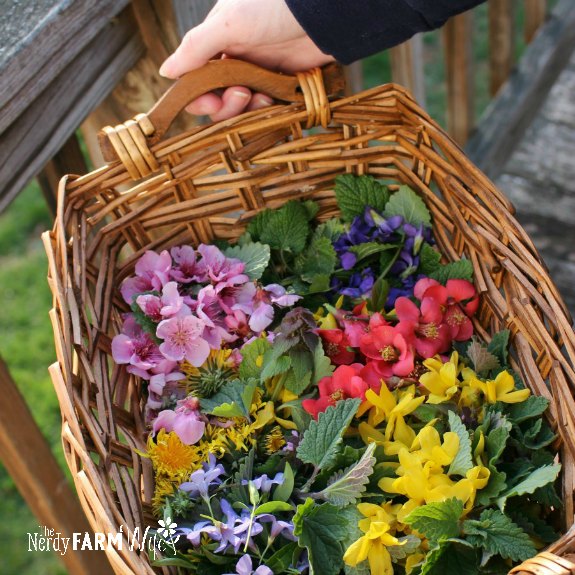
Spring has finally started to arrive around these parts!
Yesterday, I took a walk with my daughter and we collected all of the pretty flowers and herbs shown in the basket above. After she asked me about how I planned to use some of the flowers, I realized that I’ve never written up a “things to make” post about one of my spring favorites – forsythia flowers!
Forsythia bushes (Forsythia suspensa, F. spp.) not only offer a pretty burst of color in early spring, the flowers are also edible and can be used in many food and DIY beauty & body care recipes.
In THIS STUDY in the Frontiers in Pharmacology Journal I learned that “Forsythia sp. fruit preparations are traditionally used to treat infectious and inflammatory diseases, especially in Chinese medicine, and the in vitro and in vivo activities of such preparations have been proven scientifically… However, in temperate climates… fruits are not produced. The only viable sources of forsythia active compounds are the flowers and leaves.”
Of current interest for spring 2020 – forsythia is part of an anti-viral formula being studied in China. (Also see Stephen Buhner’s herbal protocol.)
More interesting sources/studies to read:
- The Mechanism of Phillyrin from the Leaves of Forsythia suspensa for Improving Insulin Resistance
- Anti-inflammatory and Antimicrobial Effects of Heat-Clearing Chinese Herbs: A Current Review
If you’re pregnant or nursing or have any concerns, don’t take forsythia internally without checking with your healthcare provider first.
Some links on this site are affiliate links; I only recommend products I personally use and enjoy. As an Amazon Associate, I earn from qualifying purchases.
Here are 11+ fun and creative things to make with forsythia flowers:

1. Forsythia Infused Oil
Make up a jar of this oil to have on hand for lotions, creams, soaps, body butters, lip balm, and lotion bars.
To make: Collect fresh forsythia flowers and spread them in a single layer on clean dish towels or paper towels. Allow to air dry for a few days. Fill a jar half-way with dried flowers, pour oil into the jar until it’s almost filled, then stir a few times to release air bubbles. Suggested oil types include olive (for soapmaking) or sunflower, grapeseed, sweet almond, apricot kernel, or rice bran for lotions, creams, and lotion bars.
For a quick infusion, heat the jar of oil uncovered on low for 2 to 3 hours in a small saucepan containing a few inches of water. For a slow infusion, cover with a lid and infuse at room temperature in a cabinet for 4 to 6 weeks before straining and using.
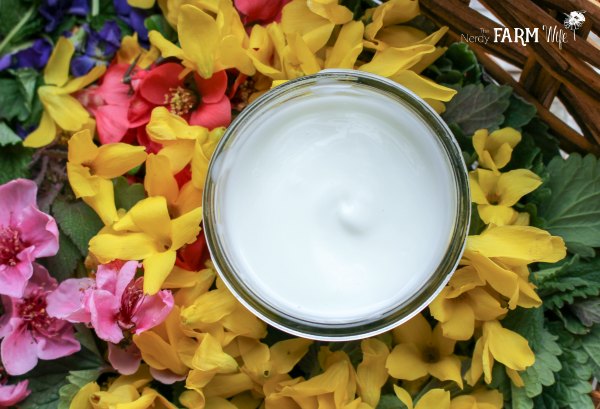
2. Forsythia Flower Lotion
This lightweight lotion is especially suitable for those with oily and acne-prone skin, but can be used as a non-greasy moisturizer for all skin types. You’ll need an accurate scale (I use THIS ONE) to make this recipe.
- 17 g forsythia infused grapeseed (or your favorite) oil (see #1 above)
- 5.5 g emulsifying wax (Mountain Rose Herbs or Amazon)
- 50 g distilled water
- 25 g witch hazel
- preservative of choice*
- optional – 1 to 2 drops of tea tree or lavender essential oil
Directions to make forsythia flower lotion:
- Weigh the distilled water and witch hazel in a heatproof container.
- Weigh the infused oil and vegetable emulsifying wax in a separate heatproof container. (I use two small 4 oz jelly/canning jars.)
- Place both jars down into a saucepan containing a couple inches of water, forming a double boiler of sorts.
- Turn the burner to medium low and heat until the wax is fully melted – about 10 to 15 minutes.
- Pour the hot water/witch hazel and melted wax/oil together into a clean jar and stir briskly with a fork for several minutes.
- Stir frequently. The lotion will thicken as it cools. I often place the container down into a bowl of ice water to help speed this step up.
- Once cool enough for your preservative of choice, stir that in and mix well.
- Add essential oil if you’d like. Tea tree is especially helpful for acne prone skin, while lavender is nice for all skin types.
- Pour into lotion containers or jars. Jar shown is a 4 oz canning jar.
* There are many choices when it comes to preservatives. I currently like Leucidal SF Complete (ECOCERT/COSMOS approved, Lactobacillus & coconut ferment) used at 4% (or 4 grams in this recipe).
Check my article, Natural Preservatives for Homemade Lotion (An Experiment) for more on this topic.
3. Forsythia Jelly
For a tasty addition to your pantry, try forsythia jelly which tastes a bit like honey. (Yum!)
Learn how to make this delightful spring treat by visiting our family’s site – Unruly Gardening. ?
4. Forsythia Clear Skin Toner
This toner is great for skin that tends towards redness and breakouts. To use, dampen a fresh cotton ball with the toner and swipe over your face after washing.
- 1/2 cup loosely packed fresh forsythia flowers (or half as many dried)
- 1/2 cup simmering hot water
- 1/4 cup witch hazel
- 1/4 tsp vegetable glycerin
Pour the hot water over the forsythia flowers and steep for 10 to 20 minutes or until the water has turned a light yellow color. Strain. Mix 1/4 cup of forsythia/water infusion with the witch hazel and glycerin. Stir well and pour into a small glass bottle or jar. Store in your fridge for 5 to 7 days.
(Recipe excerpted from my print book – The Big Book of Homemade Products for Your Skin, Health & Home.)
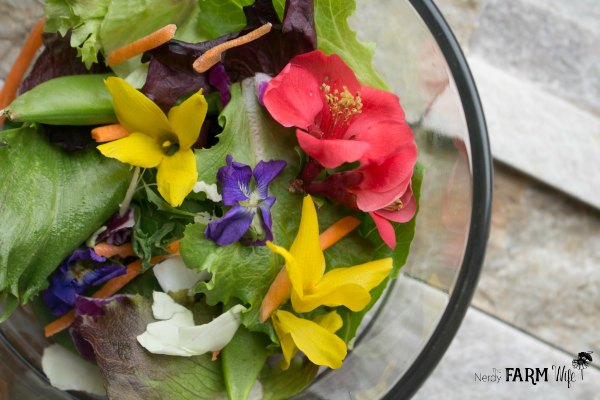
5. Forsythia Salad Toppers
Forsythia flowers are edible and can be used to sprinkle over salads along with other spring blossoms such as violets and flowering quince.
They add such a simple and pretty touch to mealtimes!
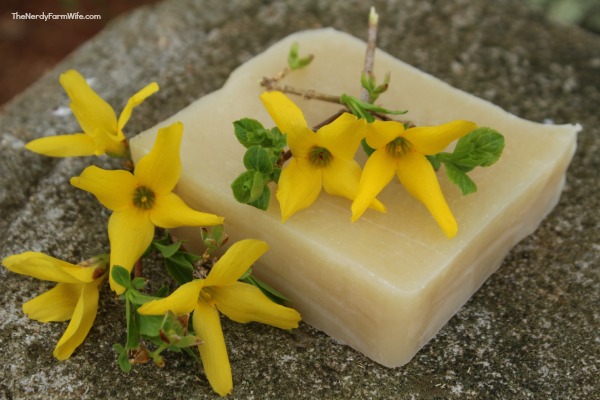
6. Forsythia Flower Cold Process Soap
This cold process forsythia soap recipe includes both a tea and infused oil made with forsythia flowers, giving it a light natural yellow color.
Read more about it in my article on how to make forsythia soap.
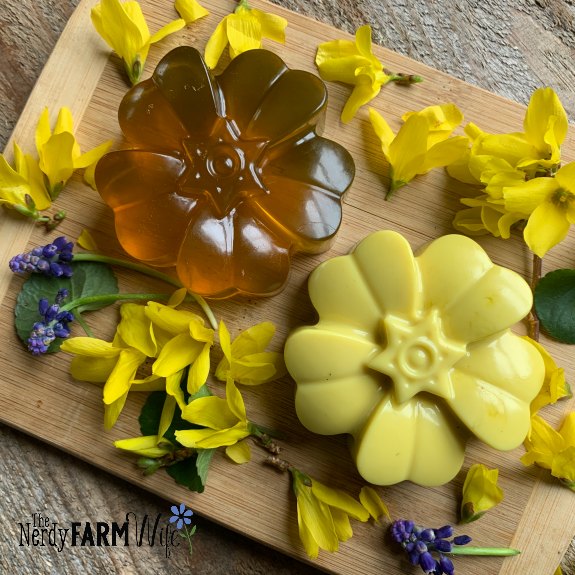
7. Forsythia Flower Infused Melt & Pour Soap
Did you know that fresh or dried flowers and herbs can be directly infused into melt and pour soap base, for both added color and skin benefits?
I cover this technique a lot in my print book, Easy Homemade Melt & Pour Soaps.
Here’s how you can infuse soap base with forsythia flowers!
You’ll need:
- 1/8 cup fresh forsythia flowers
- 1/4 tsp water
- 4 oz (113 g) white or clear melt and pour soap base
Clear soap base will create a dark yellow tone, while white soap base yields a softer pastel yellow.
Place the forsythia flowers in the bottom of a half-pint or similarly sized heat proof canning jar or container. Add the 1/4 tsp water, then fill the jar with soap base.
If you’d like to jump start the infusing process, you can microwave the jar for about 20 seconds, or until the soap starts melting.
Next, place the jar down into a small saucepan containing a few inches of water. Cover the jar with a lid and allow it to infuse for about 25 to 35 minutes, or until the soap has taken on a yellow color from the forsythia flowers.
Remove from heat and pour the hot soap base through a strainer, into silicone soap molds. (I used a Celebrate It! Flower Mold from my local Michaels craft store for the soaps in the photo above.)
Once completely cooled and hardened, remove from the mold and wrap airtight in plastic wrap, or biodegradable shrink wrap.
You can enjoy your soap right away!
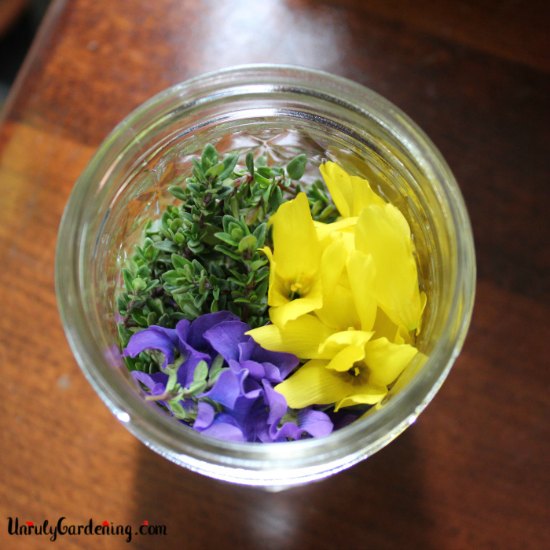
8. Spring Cleaning Face Wash
This recipe was created by my daughter, and shared over at our family website Unruly Gardening!
She uses it to help clear up acne, but I also steal some frozen cubes of it sometimes to help with itchy skin conditions like bug bites or briar scratches. :)
You can find the full recipe over at Unruly Gardening.
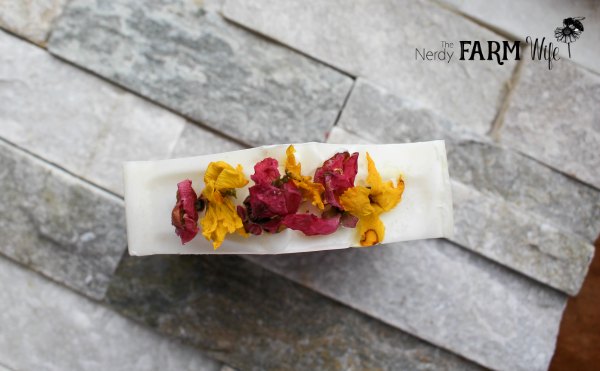
9. Forsythia Flower Soap Toppers
You can also dry the flowers and use them to decorate handmade soap. Press the centers very lightly onto the top of your soap. Avoid pressing too hard into the soap batter or the petals will turn brown – see the bottom right petal for an example.
Store flower-topped soaps out of direct sunlight to prevent the blooms from fading too fast. (Photo shows dried forsythia + dried flowering quince blossoms.) They won’t keep their color a whole year, so try to use this soap up a few months after it has cures.
10. Forsythia Flower Honey Syrup
This delicious forsythia flower syrup is naturally sweetened with honey and is perfect served over pancakes or stirred into tea.
Learn how to make this yummy recipe by visiting Grow Forage Cook Ferment.
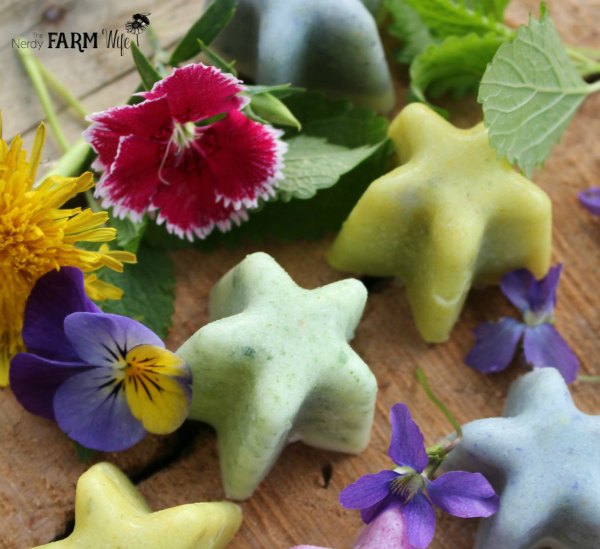
11. Floral Foot Scrub Bars
These pretty floral foot scrub bars are simple to make and require just three ingredients: sea salt, fresh flowers, and coconut oil. They’re perfect for smoothing rough feet and getting them ready for sandal weather!
Learn how to make them by reading my blog post, Spring Flower Foot Scrub Bars, and using forsythia flowers in the recipe.
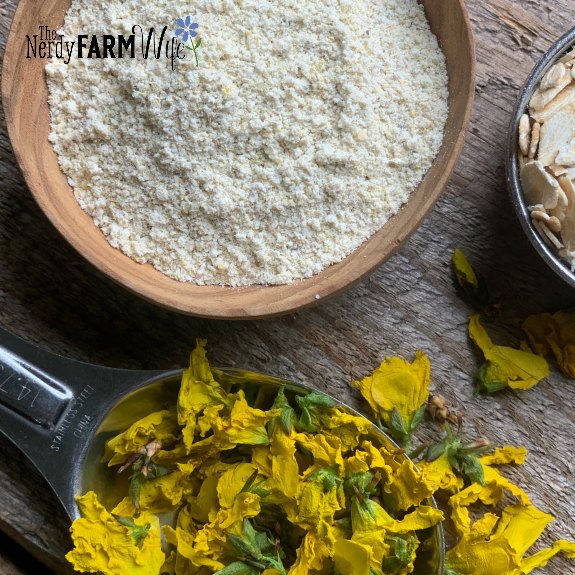
12. Forsythia Cleansing Grains
This is a variation of the “Floral Cleansing Grains” recipe in my Big Book of Homemade Products for Your Skin, Health & Home.
These flower and oat packed cleansers gently exfoliate your skin, leaving it feeling soft and smooth.
To make, combine 2 tablespoons of rolled oats with 1 tablespoon of dried forsythia flowers in a coffee grinder. You may also wish to add 1/4 to 1/2 teaspoon of your favorite clay – Yellow French clay or Yellow Brazilian clay are two good options that are gentle and suitable for a range of skin types.
Grind all of the ingredients together in the coffee grinder until finely powdered. Store in an airtight container to keep fresh and dry.
To use, splash your face with comfortably warm water to dampen your skin. Place 1 to 2 teaspoons of cleansing grains in the palm of your hand and mix with warm water, or another liquid such as coconut milk, aloe, hydrosol, yogurt, or with hazel to form a paste. Rub over your face and throat, then rinse off with warm water.
Further Reading
You can also learn more about forsythia at these other great sites:
This article, Things to Make with Forsythia, was originally published April, 2018 and updated March, 2020.
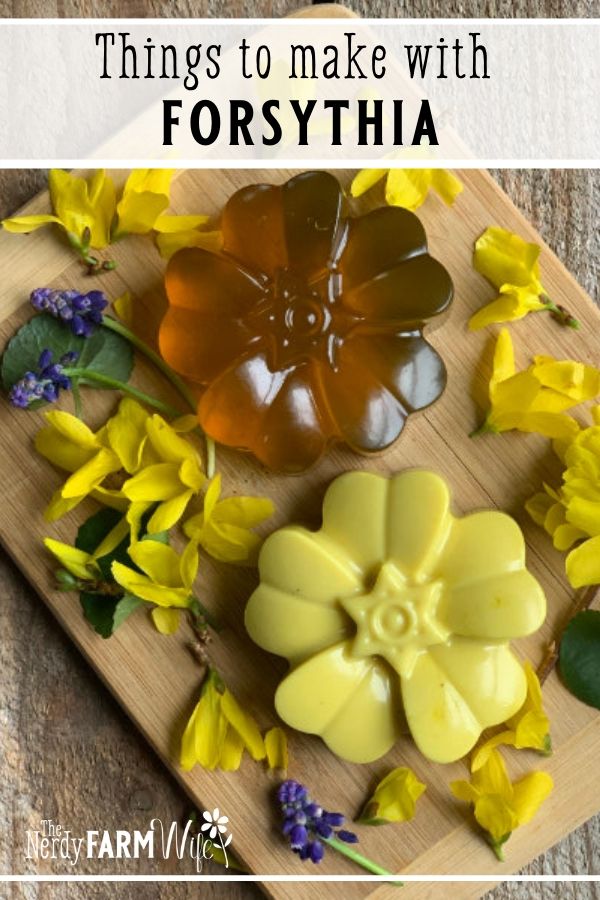

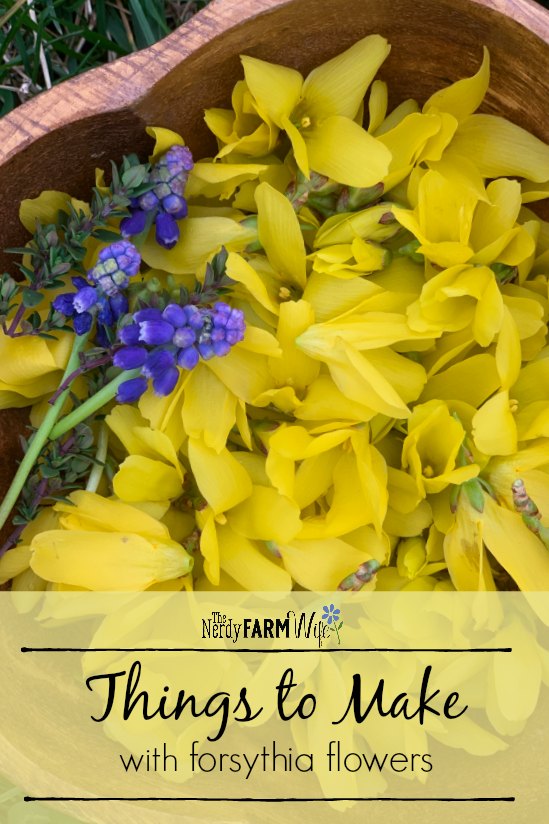
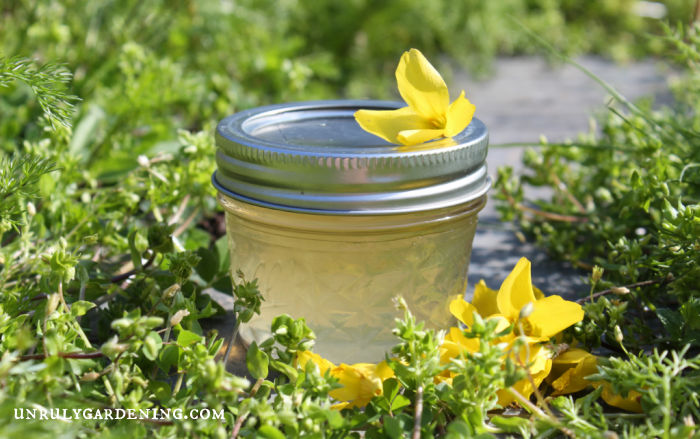
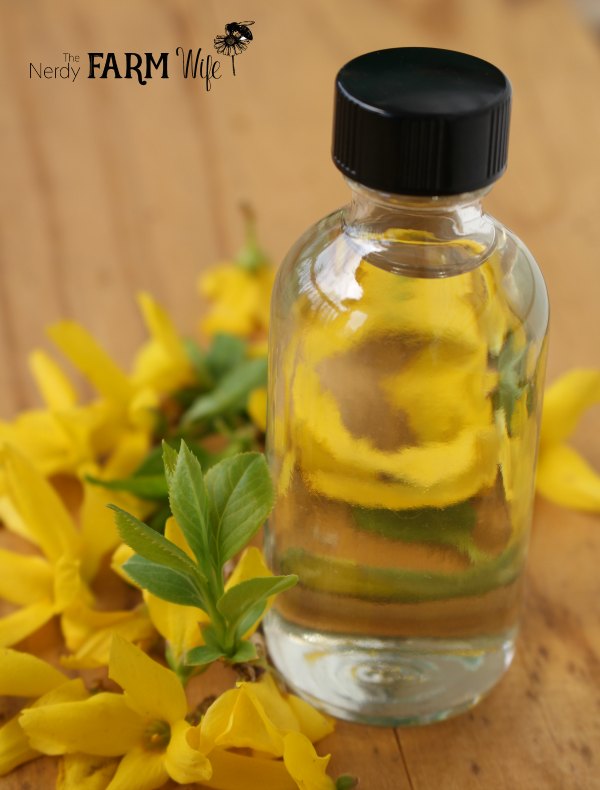

Thanks so much for including our forsythia jelly post! These are all great ideas – that lotion looks divine.
Hi Tessa! Thank you for letting me link to your yummy jelly! :)
oh wow thank you as I did not forsythia flowers were edible
sharing Kathy
Hi Kathy, It’s always exciting to learn new things about the plants around us! Thanks for sharing! :)
These are great recipes! We recently moved and our new yard has more forsythia bushes than I have ever seen in one yard.
Hi Susan, I’m happy to hear you like the recipes! How fun to have so many forsythia flowers to enjoy! :)
Thanks for sharing Stephen Buhner’s corona virus protocol. Fantastic! Good article too.
Hi Joao, Glad you found it helpful! I love his work – very well researched.
Love all of these ideas, Jan. I’m definitely going to have to dry some forsythia flowers and make those cleansing grains! As far as forsythia’s antiviral properties go, do you know if all forsythia species have that property or only the Forsythia suspensa variety? I read somewhere online than many of the forsythias growing in people’s yards are hybrid varieties that don’t have the therapeutic properties the original species has, so I thought I’d see if you knew if there was any truth to that.
Hi Meagan, That’s such a great question! I hadn’t heard that to date, but will definitely add it to my research list to explore! Thanks for asking. :)
cant wait to try some of these.
Hi Anita, That’s great to hear! I hope you enjoy your forsythia projects! :)
Great information. will look forwad to your book.